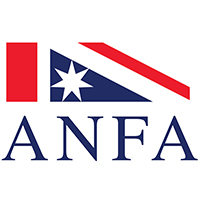Following Federation as a new nation (the Commonwealth of Australia) on 1st January, 1901 the Commonwealth Government announced a Federal Flag design competition on 29th April, 1901. The review of Review for Australiasia, a Melbourne journal, had initiated an Australian flag competition in 1900, a unique event at the time. It was agreed that the entries received by this journal would be accepted in the Government’s competition. The contest attracted 32,823 entries from men, women and children. An expert panel of judges assessed the entries using guidelines which included history, heraldry, distinctiveness, utility and cost of manufacture, On 3rd September, 1901, a public ceremony was held at the Royal Exhibition Building, Melbourne, where Lady Hopetoun, wife of the Governor-General, opened a display of the entries in the competition. The Prime Minister of Australia, Sir Edmund Barton, announced that five entrants, who had submitted similar designs, were to share the honour of being declared the designers of Australia’s own flag. They were: Ivor Evans, a fourteen-year-old schoolboy from Melbourne; Leslie John Hawkins, a teenager apprenticed to a Sydney optician; Egbert John Nuttall, a Melbourne architect; Annie Dorrington, an artist from Perth; and William Stevens, a ship’s officer from Auckland, New Zealand. The Commonwealth Government and the Review of Reviews for Australasia provided ₤75 each and the Havelock Tobacco Company added ₤50 to this making a total of ₤200 prize money, a considerable amount at the time. The five winners received ₤40 each.
The Australian National Flag features the five stars of the constellation of the Southern Cross and the Commonwealth Star, and the combined crosses of St George, St Andrew and St Patrick. The union of crosses represents Australia’s early settlers. The Commonwealth Star with its seven points represents the unity of the six Australian states and the seventh point stands for all Australian Territories. Under the Flags Act of 1953, passed unanimously by parliament, it was confirmed that our “Stars and Crosses” design be the chief national symbol by law, custom and tradition and that it be honoured with the title “Australian National Flag”. The new status of the national flag was emphasized when the act of parliament received royal assent from Queen Elizabeth II, on Her Majesty’s visit to Australia in 1954. The Australian rules of flag etiquette are designed to ensure that the national flag is displayed with the dignity befitting its status.
The Australian National Flag identifies a free and democratic people in a nation united in purpose. Our national flag belongs equally to all Australians whatever their origins. Each of the symbols on the flag has a special meaning for Australians. The stars of the Southern Cross represent our geographic position in the Southern Hemisphere; the Commonwealth star stands for our federation of States and Territories; the Crosses represent the principles on which our nation is based, namely, parliamentary democracy, rule of law and freedom of speech.
In 1996 the Governor-General, Sir William Deane, proclaimed 3rd September as Australian National Flag Day, to commemorate the day in 1901 on which our national flag of “Stars and Crosses” was first flown. It is the right and privilege of every Australian to fly the Australian National Flag.
